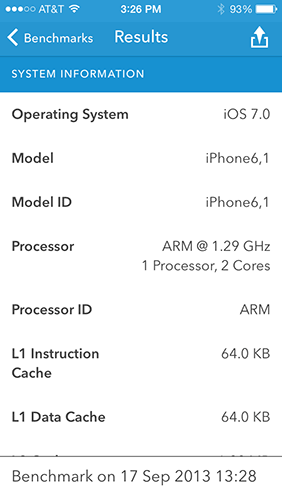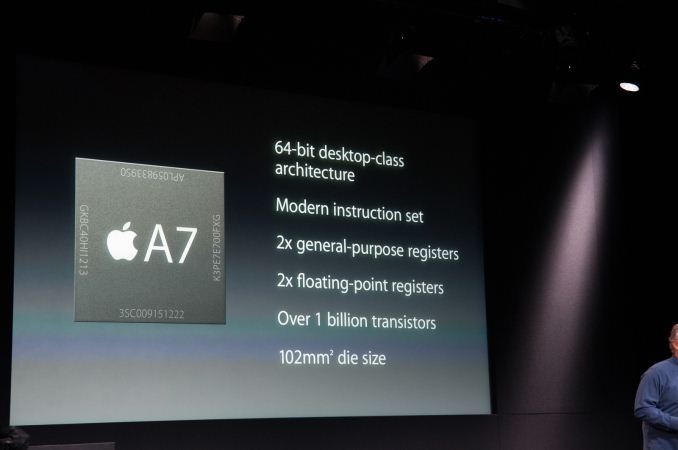The iPhone 5s Review
by Anand Lal Shimpi on September 17, 2013 9:01 PM EST- Posted in
- Smartphones
- Apple
- Mobile
- iPhone
- iPhone 5S
A7 SoC Explained
I’m still surprised by the amount of confusion around Apple’s CPU cores, so that’s where I’ll start. I’ve already outlined how ARM’s business model works, but in short there are two basic types of licenses ARM will bestow upon its partners: processor and architecture. The former involves implementing an ARM designed CPU core, while the latter is the creation of an ARM ISA (Instruction Set Architecture) compatible CPU core.
NVIDIA and Samsung, up to this point, have gone the processor license route. They take ARM designed cores (e.g. Cortex A9, Cortex A15, Cortex A7) and integrate them into custom SoCs. In NVIDIA’s case the CPU cores are paired with NVIDIA’s own GPU, while Samsung licenses GPU designs from ARM and Imagination Technologies. Apple previously leveraged its ARM processor license as well. Until last year’s A6 SoC, all Apple SoCs leveraged CPU cores designed by and licensed from ARM.
With the A6 SoC however, Apple joined the ranks of Qualcomm with leveraging an ARM architecture license. At the heart of the A6 were a pair of Apple designed CPU cores that implemented the ARMv7-A ISA. I came to know these cores by their leaked codename: Swift.
At its introduction, Swift proved to be one of the best designs on the market. An excellent combination of performance and power consumption, the Swift based A6 SoC improved power efficiency over the previous Cortex A9 based design. Swift also proved to be competitive with the best from Qualcomm at the time. Since then however, Qualcomm has released two evolutions of its CPU core (Krait 300 and Krait 400), and pretty much regained performance leadership over Apple. Being on a yearly release cadence, this is Apple’s only attempt to take back the crown for the next 12 months.
Following tradition, Apple replaces its A6 SoC with a new generation: A7.
With only a week to test battery life, performance, wireless and cameras on two phones, in addition to actually using them as intended, there wasn’t a ton of time to go ridiculously deep into the new SoC’s architecture. Here’s what I’ve been able to piece together thus far.
First off, based on conversations with as many people in the know as possible, as well as just making an educated guess, it’s probably pretty safe to say that the A7 SoC is built on Samsung’s 28nm HK+MG process. It’s too early for 20nm at reasonable yields, and Apple isn’t ready to move some (not all) of its operations to TSMC.
The jump from 32nm to 28nm results in peak theoretical scaling of 76.5% (the same design on 28nm can be no smaller than 76.5% of the die area at 32nm). In reality, nothing ever scales perfectly so we’re probably talking about 80 - 85% tops. Either way that’s a good amount of room for new features.
At its launch event Apple officially announced both die size for the A7 (102mm^2) as well as transistor count (over 1 billion). Don’t underestimate the magnitude of both of these disclosures. The technical folks at Cupertino are clearly winning some battle to talk more about their designs and not less. We’re not yet at the point where I’m getting pretty diagrams and a deep dive, but it’s clear that Apple is beginning to open up more (and it’s awesome).
Apple has never previously disclosed transistor count. I also don’t know if this “over 1 billion” figure is based on a schematic or layout transistor count. The only additional detail I have is that Apple is claiming a near doubling of transistors compared to the A6. Looking at die sizes and taking into account scaling from the process node shift, there’s clearly a more fundamental change to the chip’s design. It is possible to optimize a design (and transistors) for area, which seems to be what has happened here.

The CPU cores are, once again, a custom design by Apple. These aren’t Cortex A57 derivatives (still too early for that), but rather some evolution of Apple’s own Swift architecture. I’ll dive into specifics of what I’ve been able to find in a moment. To answer the first question on everyone’s mind, I believe there are two of these cores on the A7. Before I explain how I arrived at this conclusion, let’s first talk about cores and clock speeds.
I always thought the transition from 2 to 4 cores happened quicker in mobile than I had expected. Thankfully there are some well threaded apps that have been able to take advantage of more than two cores and power gating keeps the negative impact of the additional cores down to a minimum. As we saw in our Moto X review however, two faster cores are still better for most uses than four cores running at lower frequencies. NVIDIA forced everyone’s hand in moving to 4 cores earlier than they would’ve liked, and now you pretty much can’t get away with shipping anything less than that in an Android handset. Even Motorola felt necessary to obfuscate core count with its X8 mobile computing system. Markets like China seem to also demand more cores over better ones, which is why we see such a proliferation of quad-core Cortex A5/A7 designs. Apple has traditionally been sensible in this regard, even dating back to core count decisions in its Macs. I remembering reviewing an old iMac and pitting it against a Dell XPS One at the time. This was in the pre-power gating/turbo days. Dell went the route of more cores, while Apple chose for fewer, faster ones. It also put the CPU savings into a better GPU. You can guess which system ended out ahead.
In such a thermally constrained environment, going quad-core only makes sense if you can properly power gate/turbo up when some cores are idle. I have yet to see any mobile SoC vendor (with the exception of Intel with Bay Trail) do this properly, so until we hit that point the optimal target is likely two cores. You only need to look back at the evolution of the PC to come to the same conclusion. Before the arrival of Nehalem and Lynnfield, you always had to make a tradeoff between fewer faster cores and more of them. Gaming systems (and most users) tended to opt for the former, while those doing heavy multitasking went with the latter. Once we got architectures with good turbo, the 2 vs 4 discussion became one of cost and nothing more. I expect we’ll follow the same path in mobile.
Then there’s the frequency discussion. Brian and I have long been hinting at the sort of ridiculous frequency/voltage combinations mobile SoC vendors have been shipping at for nothing more than marketing purposes. I remember ARM telling me the ideal target for a Cortex A15 core in a smartphone was 1.2GHz. Samsung’s Exynos 5410 stuck four Cortex A15s in a phone with a max clock of 1.6GHz. The 5420 increases that to 1.7GHz. The problem with frequency scaling alone is that it typically comes at the price of higher voltage. There’s a quadratic relationship between voltage and power consumption, so it’s quite possibly one of the worst ways to get more performance. Brian even tweeted an image showing the frequency/voltage curve for a high-end mobile SoC. Note the huge increase in voltage required to deliver what amounts to another 100MHz in frequency.
The combination of both of these things gives us a basis for why Apple settled on two Swift cores running at 1.3GHz in the A6, and it’s also why the A7 comes with two cores running at the same max frequency. Interestingly enough, this is the same max non-turbo frequency Intel settled at for Bay Trail. Given a faster process (and turbo), I would expect to see Apple push higher frequencies but without those things, remaining conservative makes sense. I verified frequency through a combination of reporting tools and benchmarks. While it’s possible that I’m wrong, everything I’ve run on the device (both public and not) points to a 1.3GHz max frequency.
Verifying core count is a bit easier. Many benchmarks report core count, I also have some internal tools that do the same - all agreed on the same 2 cores/2 threads conclusion. Geekbench 3 breaks out both single and multithreaded performance results. I checked with the developer to ensure that the number of threads isn’t hard coded. The benchmark queries the max number of logical CPUs before spawning that number of threads. Looking at the ratio of single to multithreaded performance on the iPhone 5s, it’s safe to say that we’re dealing with a dual-core part:
| Geekbench 3 Single vs. Multithreaded Performance - Apple A7 | ||||||
| Integer | FP | |||||
| Single Threaded | 1471 | 1339 | ||||
| Multi Threaded | 2872 | 2659 | ||||
| A7 Advantage | 1.97x | 1.99x | ||||
| Peak Theoretical 2C Advantage | 2.00x | 2.00x | ||||
Now the question is, what’s changed in these cores?











464 Comments
View All Comments
solipsism - Wednesday, September 18, 2013 - link
I hadn't seen such a concise explanation of this tech. Thanks.Dug - Wednesday, September 18, 2013 - link
Very interesting and strange no one else has thought of doing this. I know using Nikon's system (CLS) exposure seems to be always right on, but depending on white balance setting it always needs adjustment.zshift - Tuesday, September 17, 2013 - link
Awesome review! A great read, as always.Dman23 - Tuesday, September 17, 2013 - link
Another awesome review by Anand Lal Shimpi! Informative and on point... love it.Crono - Tuesday, September 17, 2013 - link
I want to point out for the sake of consistency that Apple's naming convention is to use lowercase letters after the number for the iPhones. So it's "4s", not "4S", at least according to their website. It's annoying, I know, just pointing it out because it confused me at first so I looked it up.dylan522p - Tuesday, September 17, 2013 - link
Yeah, Brian went on a twitter rant of sorts about it. Pretty small but annoying change.tipoo - Tuesday, September 17, 2013 - link
Am I wrong, or is this the highest IPC smartphone core out there? 1.3 GHz, dual core, and it still doubles the performance of the A6 landing it into the territory most phones take higher clocked quads to get into.doobydoo - Wednesday, September 18, 2013 - link
Landing it way beyond all the current quad core phones.UpSpin - Wednesday, September 18, 2013 - link
Browserbenchmarks != CPU performanceSo it's possible that the good Browser benchmarks result more in a better optimized JS engine built for the A7? (because Samsung, NVidia, MS, ATI, Intel, ... all cheat in benchmarks, it's even possible that Apple still uses the not further optimized JS and Browser engine for the 5C, to increase the gap between A6 and A7 and make people believe the better browser scores are because of the A7, instead it's just heavy software optimization?)
Isn't it odd that a RAW CPU benchmark (3D Mark unlimited - Physics) positions the iPhone 5S on the same step as 5C and 5? (assuming there is no bug). 3D Mark also probably doesn't take advantage of 64-bit, but so will no near future App either, especially, because of the limited RAM, Games won't take 64-bit in the future either, else they'll blow the RAM limit more easily.
ScienceNOW - Tuesday, September 17, 2013 - link
F'ing thing sucks! I can all write it and we do it live! we do it live!